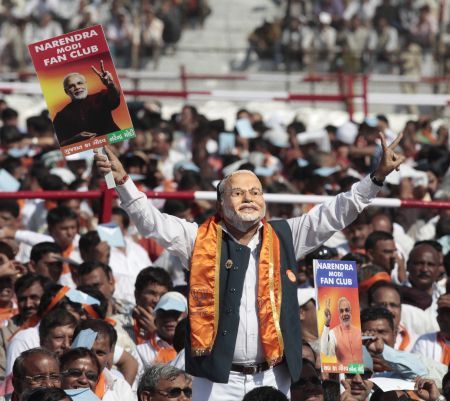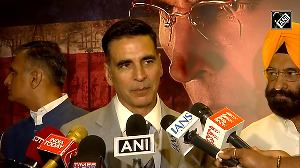 'The Modi wave is superimposed by an anti-Congress wave. While there is anger against the Congress, there is also a pro-Modi sentiment. Together, it will lead to a Modi victory.'
'The Modi wave is superimposed by an anti-Congress wave. While there is anger against the Congress, there is also a pro-Modi sentiment. Together, it will lead to a Modi victory.'
Psephologist Dr Rajeeva Karandikar explains to Shobha Warrier/Rediff.com the science behind his prediction that the Narendra Modi-led NDA will win Election 2014.
Dr Rajeeva Karandikar, director of the Chennai Mathematical Institute, is one of India's leading mathematicians and psephologists.
He had predicted the Dravida Munnetra Kazhagam's success in the 2006 Tamil Nadu election, and the All India Anna Dravida Munnetra Kazhagam's success in 2011, Nitish Kumar winning in Bihar in 2005 and 2010 and also Mamata Banerjee's victory in 2011.
The exit poll he has just conducted for the CNN-IBN television channel predicts a comfortable win for the National Democratic Alliance (270 to 282 seats).
Dr Karandikar, right, below, tells Shobha Warrier/Rediff.com how he and his team conduct exit polls and the mathematics involved.
Almost half a dozen exit poll results came out on Monday including yours for CNN-IBN. There is some difference between all of them. How much do you expect your poll results to come right because in 2004 and 2009, many exit poll results went wrong?
Yes, in 2004, it went horribly wrong, but I was not involved. In 2009, I won't call our survey was wrong as we got our indication correctly. We said 235 seats for the UPA, and they got 260. This time, I expect the direction right. The mid-point of ours was 276 for the NDA and I expect plus or minus 20 seats.
How important is samples to get the exit poll results right?
For exit polls, the choice of sample is the most important criterion. In fact, in my opinion, an exit poll in India is very difficult. That is why we do the survey a day after the poll and not when they come out of the polling booth.
What is the advantage in conducting a survey a day after the poll?
The randomisation and proper sampling do not work well when you do exit polls after polling. You can't stand there with a list of names and questions asking people who they voted for. We have to leave that to the enumerator; to whom to talk to.
How do you choose the sample in a diverse country like India?
First, we randomly choose constituencies. Then, we randomly choose polling booths. Then, we get hold of the voters list and randomly choose voters. Most poll surveys decide the kind of sample they want but we choose only randomly. We do not decide the profile but randomly choose them. Many choose male and female separately but we do not do that too.
It is like you put 10 names in a box, shake it and then take out a name without looking at it. When we use the random method, we generally get things right.
What about the different states in India, the conditions of which are so different from each other?
We use a technique called systematic sampling which automatically gives each state proportional number of constituencies, at least each of the big states. If there are 130 constituencies nationwide, our systematic sampling will give me 10 constituencies from Tamil Nadu automatically. This is the technical way which is statistically based. As we follow a proper methodological poll, we do not have to use our intuition. We strictly go by what our numbers say.

How much will the results go wrong if the samples are not right?
It can go completely wrong. If the samples are not right, the poll will have no meaning. Then, it will be like the 2004 situation.
How different is it for doing an exit poll for an assembly election and the Lok Sabha election?
Mathematically, there is no difference; it is quite similar. The methods we use are the same. The only difference is, carrying out a nationwide poll requires a lot more manpower and a lot more money.
I had 21,000 samples for the Lok Sabha elections but for an assembly election, I might have got a maximum of 5,000 to 6,000 samples.
How does a small sample of 21,000 work in a country of a billion people? Because you choose randomly?
Yes, that is the power of choosing by random. It is the methodology of choosing a sample randomly that works in such a huge country.
You were bang on in many assembly elections exit poll results. Did you find predicting a nationwide poll tough?
In a way, yes. That is because in our country with so much diversity, a state like Uttar Pradesh has no connection whatsoever with for example, Tamil Nadu. So, if we take each state separately, the sample size will be small for each state. That is where the challenge lies.
In a nationwide survey, I may get all states wrong but get the national picture right. That is because I may overestimate some states and I may underestimate some other states. But the overall result may come right.
If it's a state poll and let’s take Tamil Nadu, if you underestimate the AIADMK by 3 percent, that will have a huge impact on the overall result. But in the case of a nationwide poll, I may overestimate the Bharatiya Janata Party in some state and underestimate it in some other states, still, I may get the overall performance of the BJP nationwide, right. That is why the poll can be a little more reliable then. Still, our record at the state level has been very good.
In a state like Kerala, rarely do exit polls come right. We get to see totally different predictions. Is it because there are only two fronts in Kerala and a slight swing can make a huge difference in the number of seats?
I don't agree with the observation that our predictions went wrong but I would say Kerala is a psephologist's nightmare. Generally, it is a very close fight there and the margins of victory are very narrow. That is why we can go off the mark. A couple of points' difference in the vote estimate can make a huge difference in the numbers. Yes, that is because even a small swing can change the whole scenario.
Is there any difference in the way you conduct the survey when the fight is between two fronts and when there are more than 3 or 4 fronts like it is in Tamil Nadu now?
Yes, there is a methodology when there are only two fronts and it changes when there are more fronts. The methodology is not the same. We look at how many significant players are there in each constituency. It is not guess work; we follow a methodology.
Mathematics plays a major role in the getting the exit poll results right.
How much does the bias of a researcher affect the results?
I can't say about the others but it doesn't affect in my case. I try to be completely neutral though I also have my own views. I see to it that my views don't affect the result. I try to read what people think at large and not what I think. I go with a completely open mind.
Did you see a Modi wave in the 2014 elections?
I certainly think there is a Modi wave throughout the nation, more or less. Where the BJP has good presence like in the north and the west, the wave would be translated into more seats and in the south and the east, where the party does not have much presence, the incremental wave would not give them that many seats.
The Modi wave is also superimposed by an anti-Congress wave. While there is anger against the Congress, there is also a pro-Modi sentiment. Together, it will lead to a Modi victory.
Images: Top: A scene from a Modi rally. Bottom: Dr Rajeeva Karandikar. Image courtesy: Chennai Mathematics Institute.











 © 2025
© 2025